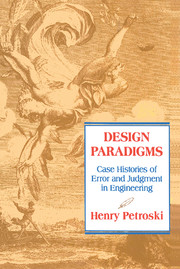Book contents
- Frontmatter
- Contents
- Preface
- 1 Introduction
- 2 Paconius and the Pedestal for Apollo
- 3 Vitruvius's Auger and Galileo's Bones: Paradigms of Limits to Size in Design
- 4 Galileo and the Marble Column
- 5 Galileo's Confirmation of a False Hypothesis
- 6 The Design and Collapse of the Dee Bridge
- 7 The Britannia Tubular Bridge
- 8 Failure as a Source of Engineering Judgment
- 9 The Design Climate for the Tacoma Narrows Bridge
- 10 Historic Bridge Failures and Caveats for Future Designs
- 11 Conclusion
- Bibliography
- Index
9 - The Design Climate for the Tacoma Narrows Bridge
A Paradigm of the Selective Use of History
Published online by Cambridge University Press: 05 June 2012
- Frontmatter
- Contents
- Preface
- 1 Introduction
- 2 Paconius and the Pedestal for Apollo
- 3 Vitruvius's Auger and Galileo's Bones: Paradigms of Limits to Size in Design
- 4 Galileo and the Marble Column
- 5 Galileo's Confirmation of a False Hypothesis
- 6 The Design and Collapse of the Dee Bridge
- 7 The Britannia Tubular Bridge
- 8 Failure as a Source of Engineering Judgment
- 9 The Design Climate for the Tacoma Narrows Bridge
- 10 Historic Bridge Failures and Caveats for Future Designs
- 11 Conclusion
- Bibliography
- Index
Summary
The design prejudices prevailing in the 1920s and 1930s, when the George Washington, Golden Gate, Tacoma Narrows, and other major suspension bridges were on the drawing board, evinced confidence in analytical techniques and a preoccupation with aesthetics. Almost a half-century of relatively successful experience with suspension bridges like the Brooklyn had led designers to focus on extrapolating from that successful experience. Such a focus led in turn to a climate in which some designers forgot or ignored the first principles on which the successful designs originally were based. These principles rested upon criteria that explicitly recognized wind-induced failure modes that in turn drove design decisions. Basing structural extrapolation upon models of success rather than on failure avoidance was to result in such flexible bridges as the Bronx–Whitestone, completed in 1939 over the East River in New York City, and culminate in the collapse of the Tacoma Narrows Bridge in 1940.
It is perhaps a truism that the design climate in which an engineering project is conceived and developed can have a profound effect on whether it succeeds or fails, but the significance of the interaction between success and failure in design can sometimes be so subtle as to escape even the greatest of designers. The context in which suspension bridges were being designed and built in the late 1920s and 1930s in the United States provides a classic example of the phenomenon.
- Type
- Chapter
- Information
- Design ParadigmsCase Histories of Error and Judgment in Engineering, pp. 144 - 165Publisher: Cambridge University PressPrint publication year: 1994
- 2
- Cited by



